Bees are beneficial to the economy because they pollinate commercial fruits, field crops, and vegetables. However, when they build a colony close to home, they can be a nuisance or become a threat.
How to get rid of bees naturally? There are many ways to get rid of bees naturally, and one of them is making a vinegar spray solution. Mix equal amounts of vinegar and water in a clean spray bottle. Then, shake the mixture and spray it on the nest, preferably at night, when the bees are asleep.
Furthermore, we’ll discuss more methods for getting rid of bees naturally and the purpose they serve in the ecosystem, including their identification, habitat, and threat. So, let’s get this started!
Table of Contents
What Purpose Do Bees Serve?
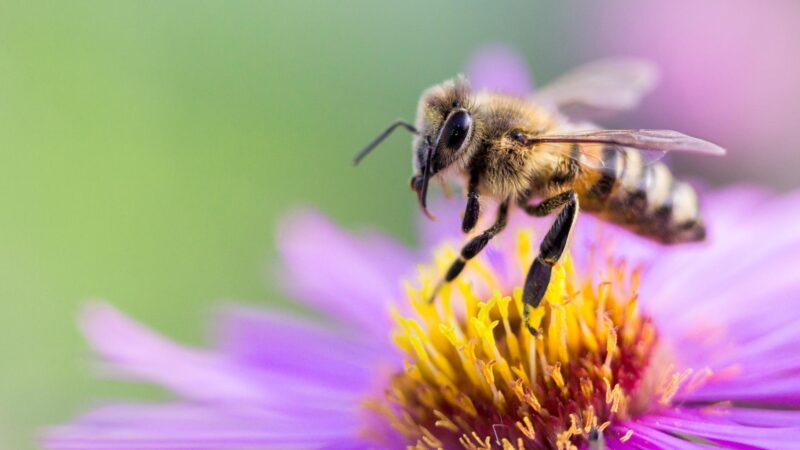
Bees are pollinators and play a significant part in each aspect of the ecosystem. They support the growth of flowers, trees, and other plants, which serve as shelter and food for the animals.
Bees, including bumble bees, are essential since they pollinate food crops. If all bees get extinct, it would shatter the balance of the Earth’s ecosystem, affecting global food supplies.
Do Bees Attack Humans for No Reason?
Bees typically sting people when they feel threatened. They tend to sting people who startle them with brisk movements or walk too near their nests.
In general, bees protect their homes just like humans do and naturally react if they sense any threats in their surroundings. If you make any sudden movements when you’re close to them, they’ll take it as a threat and would try to sting you.
So, whenever you walk close to bees, be cautious of your movements to avoid taking your actions as a sign of threat.
Bees | Identification, Habitat, and Threat
Leafcutter Bees
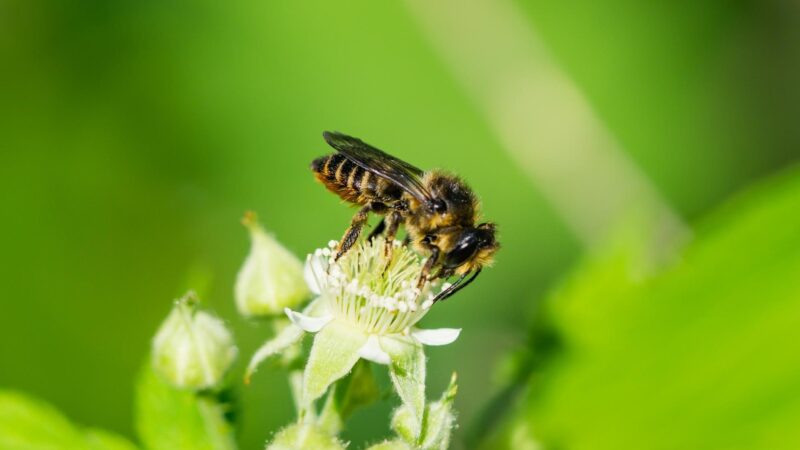
Leafcutters are lone bees and don’t live in large colonies or groups like honey bees. They also don’t aggressively defend their nesting areas like the honey or bumble bees do.
Their sting has been portrayed as less painful than honey bees. They only sting if mishandled but don’t pose any threat at all.
Identification
Most leafcutting bees are medium-sized, around 5 mm to 24 mm, having stout black bodies. The female leafcutter bees, except the parasitic Coelioxys, carry pollen on their hairs that are found on the abdomen’s underside instead of on hind legs like other bees.
When they start pollinating, their abdomen’s undersides will appear light yellow to deep gold in color.
Habitat
- Forests
- Heath
- Woodlands
- Urban areas
Threat
Leafcutter bees threats include:
- Climate change
- Degradation
- Diseases
- Habitat loss
- Pesticides
Bumble Bees
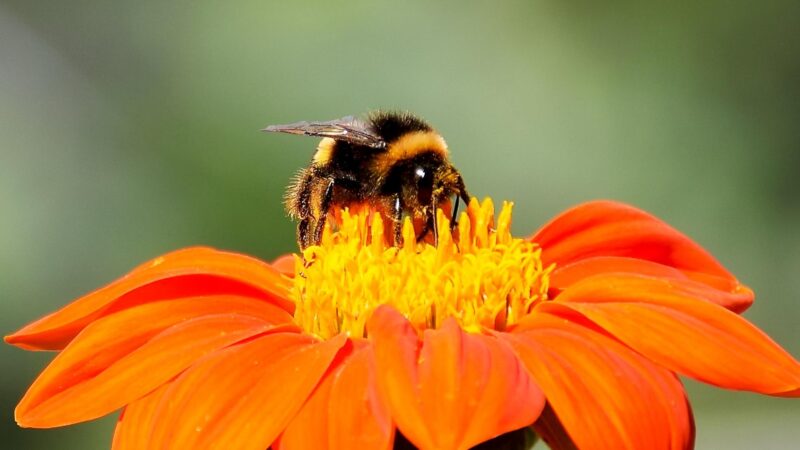
Bumble bees are among the most social creatures in the animal kingdom that live in a group called a colony. According to National Wildlife Federation, a colony can comprise 50 to 500 individuals, and the queen rules among them.
Other bees function as servers to the queen, gather food, and care for the growing larvae. During the late fall, the whole colony dies, besides the queen.
She hibernates every winter period under the ground and creates a new colony in the spring.
Identification
Bumblebees are relatively large, hairy insects with short, thickset wings. They’re bigger than honeybees but don’t deliver as much honey.
Habitat
Most of the time, bumblebees make their nests in the following sites:
- Abandoned rodent tunnels
- Compost piles
- Dead leaves
- Under piles of wood
Threat
Bumblebees face multiple threats, such as:
- Climate change
- Disease
- Habitat loss
- Pesticide
Carpenter Bees
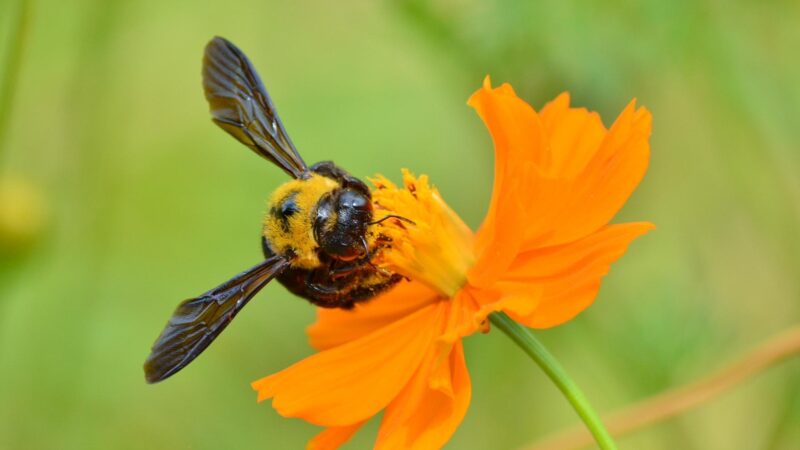
With over 20,000 different bees species globally, a few of them are more of a burden than a help, like the Carpenter bee. They have a comparable build to Bumblebees, particularly in shape and size.
However, bumblebees typically nest in the ground, while carpenter bees nest and deliver their eggs in the wood they have drilled for protection. Furthermore, these bees don’t live in colonies like bumblebees or honeybees.
The adults overwinter separately, often in earlier built line tunnels. Those bees that survive the winter arise and mate during spring.
The fertilized female bees then bore into wood, burrowing a tunnel to lay their eggs. The hole entrance in the wood surface is round with coarse sawdust in the opening.
Tunneling sounds can also be heard occasionally within the wood. Hatching and maturation happen over several weeks, with the pollen acting as a food source for the growing larvae.
After summer, the new adult bees’ generation appears and feeds on flowers and returns to their wooden den in the fall for hibernation.
Identification
Carpenter bees have black and shiny abdomen. Males possess orange and black color, while females are entirely black.
Habitat
Some of the typical carpenter bee nesting sites are:
- Decks
- Eaves
- Fascia boards
- Rafters
- Siding
- Wooden shake roofs
- Outdoor furniture
Threat
Some threats to carpenter bees include the following:
- Woodpeckers (primary threat)
- birds, like bee-eaters and shrikes
- Insecticide
- Deforestation
Sweat Bees
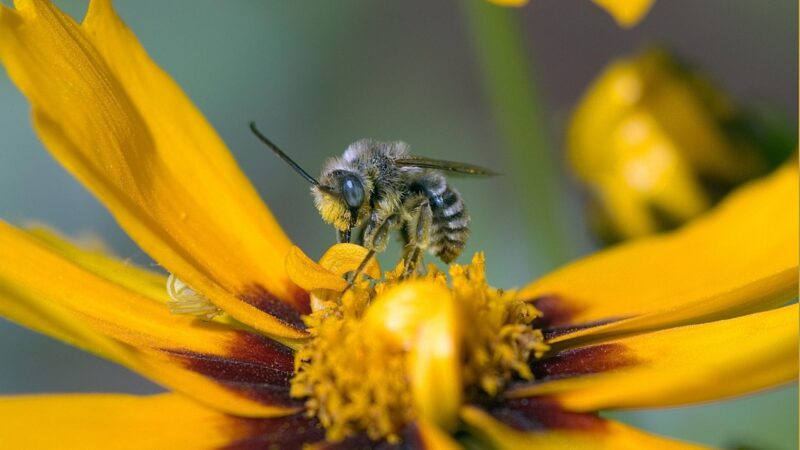
Sweat bees are relatively small, metallic, often shiny green bee species. They usually overwinter as larvae or pupae in burrows in the soil.
These are often annoying to humans since they’re attracted to human sweat. Females sting, but the pain is just mild.
Stings generally happen when one attempts to brush them off their body.
Identification
Sweat bees are minuscule-sized bees that are often confused with ants or flies. They mainly have vibrant and shiny green metallic colors with yellow markings, making them more appealing.
Habitat
Almost all sweat bees nest in the ground, while few of them nest in rotten wood. Adults are typically seen as they feed on pollen and nectar, among flowers in grasslands, gardens, fields, roadsides, and other open areas where flowers are ample.
Threat
- Climate change
- Habitat loss and fragmentation
- Invasive plants and bees
- Low genetic diversity
- Pesticides
Mason Bees
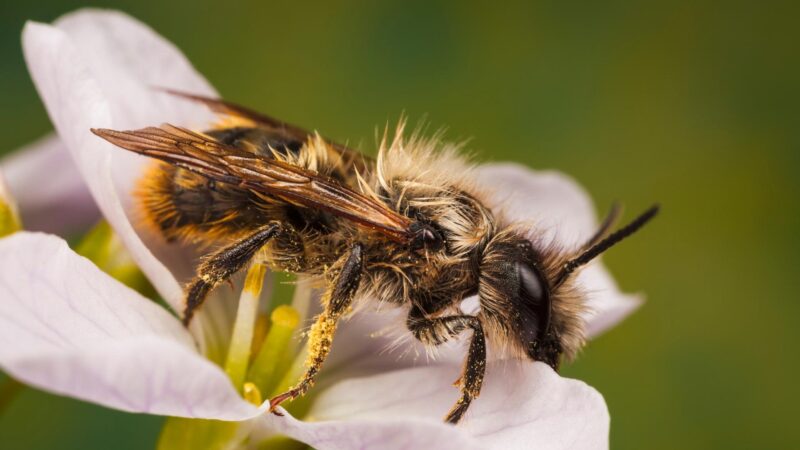
For beginners, mason bees don’t produce honey. But, they have outstanding pollination skills, making it viable for plants to develop seeds and reproduce.
Mason bees help fruit trees boost their yield, and landscapes burst with color due to their touted pollinating ability. In fact, they’re often lauded as being more effective pollinators than honey bees.
Identification
In general, Mason bees are recognized by the metallic shade on their skin with faint lines, appearing as stripes across their skin. Unlike other bees, their lines are never red or yellow but are shiny, metallic, blue, black, and green.
Habitat
Mason bees require flowers blooming in the spring and early summer for foraging and substrate habitats to build their nest. These attributes of a habitat can be found in varied places, such as:
- Coniferous forests
- Deciduous forests
- Deserts
- Prairies
- Shrublands
Threat
Some of the Mason bees’ threats include:
- Climate change
- Habitat loss and degradation
- Pesticides
Why Should You Get Rid of Bees?

Aside from the threat of stings, bees can also lure secondary insects to infest your residence because of the honey they produce.
But, since bees are highly valuable to the environment, they should only be regulated when they pose an immediate danger to your home or family.
Signs of a Bee Infestation in Your Home
There are several signs of bees infestation in your home, and the most common and the following:
Seeing an Excessive Number of Bees
The first sign that you might have a bee infestation is when you see an outrageous number of bees flying around your property. Not only is this highly annoying and stressful, but it can also be unsanitary, as bees can bring in various bacteria from the outside.
Active Nest
If you spot an active nest of bees—whether in the internal structure of your place or outdoors, bees are probably invading your home. Active nests can be found in trees, in your garage or shed, underneath your home’s floorboards, or in wall voids.
Dark Patches on the Walls or Ceilings
If you see dark patches arising on your ceilings or walls, this could be a sign of honeybee infestation. Honeybees typically build their nest in-between walls or the canopies and produce their honey there.
How to Get Rid of Leafcutter Bees Naturally?
Despite being helpful to pollination, they may cause disturbances when they reside within your vicinity. So, it’s crucial to ward them off by doing the following:
- Put two drops of sealing wax or white glue on the end of plants you prune, like rose bushes. This discourages the leafcutter bees from building nests in the open holes caused by pruning.
- Cut any damaged or dead stems from your rose bush using gardening shears. These bees are drawn to soft rotting or dead wood. Removing them from your flowering plant will dissuade the bees from constructing their homes close to your flowers.
- Cover exposed plants with cheesecloth or another loose mesh when leafcutter bees are most active, usually during late summer.
How to Get Rid of Bumble Bees Naturally?
To get rid of bumble bees naturally, consider doing the following steps:
Vinegar Spray
- In a mixing bowl, mix equal parts of water and vinegar.
- After thoroughly mixing the two ingredients, put the solution into a clean spray bottle.
- Once done, spray the hive with the vinegar solution at night when bees are at rest. Make sure to wear protective clothing, such as gloves, overalls, etc.
Citrus Spray
Applying citrus spray to the hive is another suitable way to ward off bumble bees. To do this:
- Slice a lemon, put the slices in a pan with water, and bring them to a boil.
- Once the boiled water is down to one-third, transfer it to a clean spray bottle.
- Once done, spray the citrus solution around the hive and flower beds.
Cinnamon Powder
The sweetest way to eliminate bumble bees without killing them is using cinnamon powder. Just spread some grounded cinnamon close to the hive at night for several weeks, and it’ll encourage them to vacate the area.
How to Get Rid of Carpenter Bees Naturally?
Although carpenter bees are generally docile, they can still induce concerns in your home. Males usually hover outside the nest to fight and protect intruders by engaging in physical battle, despite the fact they don’t have a stinger.
Only the females have a stinger, and they act as the last line of defense when their nest is threatened. The actual issue with Carpenter Bees is the damage they can cause to wooden parts of your home.
These tiny insects excavate holes out of soft wood and make a series of underpasses to lay their eggs and seek shelter from the harsh weather and threat outside of the nest. Though this doesn’t seem too alarming, it’ll do a lot of damage to your residence over time.
To get rid of the bees naturally from your area, consider using the following:
Citrus Spray
The strong scent of citrus is highly offensive to carpenter bees. So, make your own citrus spray. To do that:
- Boil citrus peels in water.
- After that, put the solution into a clean spray bottle.
This way, you won’t have to boil citrus peels often and simply spray directly your wooden items effortlessly every few days.
Almond Oil
When used to wood, almond oil has corresponding repelling effects to citrus spray. Carpenter bees despise the scent, keeping them from building a nest on sprayed wood.
To make the almond solution:
- Mix equal parts of almond oil with water and spray it spray on wood, or apply it straight to the nest holes of carpenter bees.
Borate
Another item that you can use is borate. You can use this as a wood treatment for your complete and unfinished wood. This solution is chemical-free and is a fantastic method to protect your wood from these wood-boring insects.
Before applying the borate on wood, make sure the area of your wooden items is clean and dry. For the correct usage, read the product’s label.
Play Loud Music
Playing loud music bothers carpenter bees as they’re highly sensitive to sounds and vibrations. So, use this to your advantage and play loud music to make the bees decamp from your place.
Pyrethrum Spray
The pyrethrum spray is a natural pesticide used to repel carpenter bees and other wood-boring insects. You can purchase this item online or look for it in your local stores.
How to Get Rid of Sweat Bees Naturally?
Sweat bees are usually allowed to thrive due to their significant contribution to pollinating crops. And since these bees are relatively peaceful, there’s no reason to regulate them in most cases.
However, if you have a huge infestation in your place or you’re severely allergic to them, you can use the following method to manage them.
Sweat Bee Natural Repellent
There are several natural sweat bee repellents available on the market today, and some of them are:
Mint Rub
A mint rub is a speedy and easy way to discourage bees from getting attracted to your skin, especially when you sweat. The rub can be a simple mint lotion or soap.
To make an effective rub, simply:
- Fill a bottle with half water and add two drops of peppermint extract into the water.
- Once done, spray the peppermint mixture on your skin.
Commercial Repellents
There are natural repellents that work best in keeping sweat bees away from you, and some of these products are:
- Repel Lemon Eucalyptus—A cool spray with a refreshing scent. It’s plant-based and works well in keeping sweat bees away effectively.
- Burt’s Bees Natural Herbal Insect Repellent—Another 4-ounce spray containing citronella, lemongrass, and soybean oils. All you have to do is spray this on your skin to ward off sweat bees.
How to Get Rid of Mason Bees Naturally?
Though mason bees are beneficial to man, particularly in pollinating fruits and crops, their nests can create problems in homes. They can also cause serious damage to garden plants.
Hence, getting rid of mason bees naturally is a must. However, getting them out of house walls can be more challenging than you ever imagine since you need to fill up all the holes formed by them during nesting.
In most cases, pest control services are required to effectively get rid of these bees.
When to Call Professionals?
It’s best to call a pest control professional when bees’ nests are in tricky locations, such as siding of your home, in the ground, and other hard-to-reach areas. This is the bread and butter of professionals, so take advantage of their expertise to solve your bees’ issues.
They have a better understanding of bees management and the impact of bees on the environment. Out of all the people, they know how to find the best way to deal with bees without killing them.
So, call a local pest control expert whenever you have difficulty in getting rid of bees naturally.
Summary
Bees are valuable insects in the ecosystem, but they can also be threatening when they build their nests near a house or site of business. To prevent bee infestations, you can use natural home remedies, such as vinegar, citrus, and other non-chemical alternatives to ward them off without killing them.